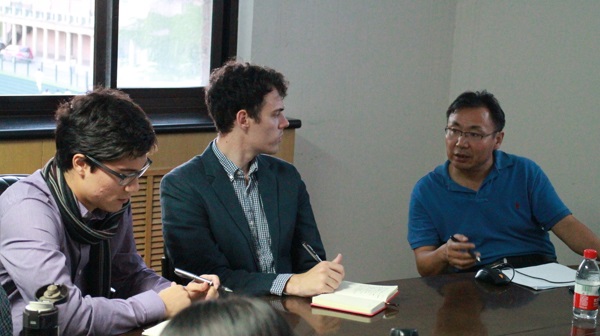On Monday, Sept. 19 2016, NexGen Forum Fellows met with Mr. Guan Shanyuan, Deputy General Manager of China-Africa Agriculture Investment Co. (CAAIC) in Tanzania. He presented an in-depth description of CAAIC’s operations in Tanzania and provided the Forum with a well-rounded case study on Chinese economic engagement in Africa.
On Monday, Sept. 19, NexGen Fellows met with Mr. Guan Shanyuan, General Manager of China-Africa Agriculture Investment Co. (CAAIC) in Tanzania. CAAIC is a joint-venture between the China National Agricultural Development Group Corporation and the China-Africa Development Fund, and is the largest Chinese platform for agricultural investment in Africa. Drawing from his eight years of experience working for CAAIC in Tanzania, Mr. Guan’s presentation on the activities and structure of CAAIC provided unique insight into Chinese economic engagement in Africa.
Mr. Guan began his remarks with an overview of CAAIC’s activities in Tanzania, where they have operated a sisal fiber farm since 1999. Sisal is native to Southern Mexico, but cultivation of the sisal plant for its valuable fibers spread throughout the world in the 19th century. Sisal fiber was originally used for rope and twine, but through modern manufacturing techniques sisal fiber has become a component in a range of consumer and industrial goods, ranging from apparel and rugs to geotextiles and elevator cables. Sisal production is an important component of Tanzania’s agriculture-based economy, where it is predominantly exported to China, Europe and the United States.
Given the labor-intensive nature of sisal fiber production, Mr. Guan feels that the greatest benefit CAAIC provides to the local community is its ability to provide large-scale employment opportunities, in an area where industry is unevenly distributed. The number of local staff employed depends on the number of sisal plants under cultivation, which take four years to mature. Mr. Guan explained that CAAIC has employed as many as 1000 local staff, but currently employs 600 due to a drop in investment four years prior, highlighting the inherent challenge in managing output of crops like sisal where maturation is a long-term endeavor. Given current investments being made towards increasing production, Mr. Guan expects employment to rise in coming years as new plants mature. CAAIC is also making long-term infrastructure investments in the area, ranging from imported heavy machinery to paved roads and irrigation channels.
Throughout his presentation, Mr. Guan stressed the importance of ethical engagement with the local workforce, as well as respect for the local regulatory environment. CAAIC provides an industry-wide negotiated wage, as well as healthcare benefits to local workers. Given the lack of certain healthcare services available in the area, the procurement of medical practitioners and equipment is facilitated by CAAIC as needed. CAAIC meets regularly with local union representatives in order to address their concerns, and organizes a number of cultural and social activities for workers and their families.
In addition to workforce engagement, Mr. Guan highlighted CAAIC’s corporate social responsibility initiatives within the local community. This commitment manifests itself not only in the financial contributions that CAAIC makes to disaster relief and local healthcare, but also in the establishment of a community center which provides a space for the local community to interact, hold events and organize in civil society groups. Furthermore, he outlined the partnerships that CAAIC has established with the China Agriculture University and other organizations who provide capacity building and agricultural training to the local community.
Mr. Guan also elaborated on a number of challenges that CAAIC has encountered in recent times. While tariffs are advantageous for the export of sisal fiber, coping with bureaucratic customs processes and regulations is an ongoing challenge to CAAIC’s business development. Structural issues such as strikes that periodically halt economic activity in the country can also be an obstacle to long-term planning and CAAIC’s ability to operate profitably. But in comparison to other companies, Mr. Guan described CAAIC’s situation as less challenging due to the well-functioning communication channels established between the company management and labor unions. Mr. Guan also noted the long-term and less visible risk posed by climate change, in which floods or droughts stand to endanger sisal production. In order to address this, CAAIC has begun designing cultivation methods and adding infrastructure to alleviate the negative impacts of flooding and other weather phenomenon.
Mr. Guan concluded by emphasizing that a successful international business operation must be built upon mutual respect, an awareness of differences in cultural contexts, and a focus on mutually beneficial goals—especially those that provide tangible benefits to local communities. Overall, Mr. Guan provided the Forum with a well-rounded case study that fits well in the broader context of Chinese economic engagement in Africa, and the Forum thanks him for his in-depth presentation of CAAIC’s operations in Tanzania.
